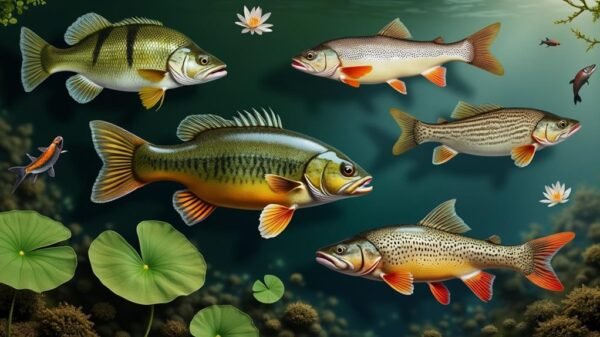Identifying freshwater fish species can be an exciting adventure that enhances your fishing game! Start by exploring different habitats like serene lakes or rapid rivers, as fish often prefer specific environments. Look closely at their physical traits—fin shape, mouth size, and colors can reveal their species. Observing behaviors, like feeding patterns and schooling, is also crucial. Utilize tools like field guides and measuring tapes to aid with identification. Don't hesitate to consult local resources, such as fishing clubs or nature centers, for expert advice. Keep going, and you'll uncover even more tips to sharpen your fish-spotting skills!
Understanding Freshwater Fish Habitats
Freshwater fish inhabit diverse ecosystems, and recognizing these environments is crucial for species identification. Still lakes and tranquil ponds provide a serene backdrop for species that prefer calm waters, while swift rivers and streams attract fish that thrive in moving currents. Familiarity with specific fish species, such as bass, bluegill, and trout, enhances your ability to identify them, as each species has its own habitat preferences.
Observe the flora as well. Lush vegetation offers refuge and breeding sites, making them key areas for various species. In riverine ecosystems, rocky substrates often serve as shelters for fish seeking nourishment and safety. Temperature and water clarity also play significant roles; fish are typically drawn to specific temperature ranges, allowing you to refine your search based on local climatic conditions.
As you explore these aquatic environments, consider the influence of seasonal changes. Species like salmon and catfish may migrate or alter their behavior with the weather, affecting your identification process. By paying attention to these factors, you'll uncover vital information about the fish species that inhabit these waters. Embrace the adventure as you traverse these habitats, and let your curiosity lead you to the captivating variety of freshwater fish that reside beneath the surface.
Recognizing Key Physical Characteristics

When identifying various species of fish, essential physical traits serve as reliable indicators. By concentrating on distinct characteristics, you can efficiently reduce your choices and enhance your identification abilities. Freshwater fish are sorted based on their thermal preferences, so comprehending these categories can also aid in your identification efforts. Here are crucial features to observe:
- Form: Notice if the fish presents a streamlined, flat, or rounded silhouette. This can reflect its swimming technique and preferred environment.
- Hue: Pay attention to the colors and patterns adorning the fish. Bright hues often suggest mating conditions or assist in blending with surroundings.
- Fin Anatomy: Count and scrutinize the fins. Different species showcase specific fin counts and shapes that can facilitate identification.
- Mouth Shape: Assess the mouth's configuration and location. A fish with a prominent, upward-facing mouth might have different feeding habits than one with a small, downward-facing mouth.
- Scale Texture: Feel the skin's surface. Some fish exhibit smooth skin, while others possess tough, spiny scales. Recognizing the distinctions among warm-water species can further enhance your identification skills.
Observing Behavior Patterns

Behavior patterns offer valuable insights for identifying freshwater fish species. By spending time observing these behaviors, you can uncover clues that lead to accurate identification. For instance, note how different fish interact with their surroundings. Some species, like Bluegill, prefer to hide among aquatic plants, while others, such as Largemouth Bass, swim freely in the water column. Understanding the various species found in lakes and ponds, like Crappie and Catfish, can provide context for their behaviors and habitat preferences.
Feeding habits are crucial too. Some fish, like Carp, are bottom feeders that sift through sediment, while others, like Shad, are surface feeders that dart after insects. Pay attention to schooling behavior; fish that travel in groups, like Perch, often indicate their species, as some prefer companionship while others, like the solitary Pike, do not.
Observe their swimming styles. Is it fast and erratic, like a Rainbow Trout, or slow and graceful, like a Koi? This can hint at the species. Be attentive to unique behaviors, such as leaping or splashing, which may indicate specific types like Bass or Salmon.
Ultimately, observing these behaviors enhances your identification skills and deepens your appreciation of the aquatic ecosystem. So grab your fishing gear, head to the nearest lake or pond, and immerse yourself in the captivating movements of freshwater fish.
Utilizing Fishing Tools for Identification

Fishing tools serve as essential companions for identifying freshwater fish species. When you venture onto lakes and rivers, these tools assist in recognizing your catch, enhancing your overall fishing experience. For instance, learning to identify common species like Largemouth Bass and Bluegill can significantly refine your fishing techniques. Here are some essential tools to consider:
- Field Guides: A reliable guidebook, like the *Peterson Field Guide to Freshwater Fishes*, features a variety of species, aiding in visual comparisons.
- Measuring Tape: Measuring your catch helps determine species and ensures compliance with legal size limits.
- Water Testing Kits: Kits such as the *API Freshwater Master Test Kit* allow you to assess water quality, indicating which fish species are likely to inhabit that environment.
- Digital Fish Scales: Devices like the *Rapala Digital Scale* can weigh your catch, providing clues since certain species have specific weight ranges.
- Camera: Capturing high-resolution images enables future identification and assists in tracking your fishing accomplishments.
Utilizing these tools enriches your ability to identify fish while deepening your appreciation for nature. Engaging with these resources boosts your confidence in recognizing various species. So, equip yourself, head to the water, and let these tools lead you on an adventure into the fascinating realm of freshwater fish.
Consulting Local Resources

Local resources can be invaluable for discovering freshwater fish species in your area. Start by contacting regional fishing clubs or community groups. They often consist of seasoned anglers who enjoy sharing their expertise and can assist you in recognizing the fish you catch. These organizations might host events or workshops dedicated to fish identification, providing an excellent opportunity for learning. Additionally, understanding specific baits, such as nightcrawlers or minnows, that attract various fish species can significantly aid in your identification efforts.
Don't overlook local libraries or nature centers. Many possess books and pamphlets tailored to the fish species in your region. These materials can offer detailed descriptions and visuals, facilitating your ability to identify different types. You might also encounter local experts who can address your inquiries.
If you're near a lake or river, consider speaking with fellow anglers. They are often eager to share advice and techniques. Sometimes, the most valuable guidance comes from individuals who have spent years fishing in the same location.
Lastly, explore online forums or social media groups focused on fishing in your region. These platforms can connect you with a network of enthusiasts ready to provide insights and share experiences. By leveraging these local resources, you will build confidence in identifying freshwater fish species and enhance your fishing experience.



























